Are you ready for the perfect three days in Kyoto? Then, you, my friend, have come to the right place. I recommend everyone to visit Kyoto on their first trip to Japan because this 1131-year-old city is like nothing you’ve ever seen.
But there’s something I have to tell you. Planning is absolutely essential to make the most out of your 3-day itinerary. And you’re in luck. After 13 years of living in Japan and six pilgrimages to this magical city, I’ve cracked the code on how to experience Kyoto’s temples without feeling like a salmon swimming upstream through the hordes of tourists, never able to get a photo without 17 other strangers in it.
Here’s the truth: Kyoto is like that popular restaurant where everyone’s trying to get a table but no one bothered to get a reservation or do anything in an orderly way. Show up during peak hours and you’ll feel more like you’re at a rock concert than in the calming presence of Buddha. You’re going to quickly lose your moment of zen when you pass 22 tour buses in the temple parking lot. But come at the right time? Pure magic. You’ll feel like you’ve stepped back 1000 years into old Japan, with nothing but the sound of temple bells and rustling bamboo keeping you company.
Let me share my absolutely perfect 3-day Kyoto itinerary that’ll help you dodge the crowds and soak in the real Kyoto. After my sixth visit, I finally got it right, and I’m excited to share it with you.
Please note: Affiliate links are used in this post. If you make a purchase, I earn a small commission at no cost to you, which goes toward the cost of maintaining this blog.
Before You Go: Don’t Forget to Purchase Travel Medical Insurance
Traveling to Kyoto is an absolute dream, and I’m excited to share my perfect 3-day itinerary with you. However, any trip can quickly turn into a nightmare if you don’t purchase travel medical insurance beforehand. I can personally recommend SafetyWing’s Nomad Essential Plan as one of the most affordable options currently on the market. You will only be charged a few dollars per day but can rest easy knowing that you’re covered if anything should go wrong while out exploring the temples of Kyoto. Just make sure to sign up before you go and remember that SafetyWing does not cover preexisting conditions.
DAY 0: Arrival Day
I’m not sure what time you’re going to arrive, but if you have a choice, I would arrive around 4:00 pm in the afternoon, check-in, have an early dinner, and try to get to sleep by 9:00 pm. Before you go to bed, stop by a Japanese convenience store and grab some yogurt, pastries, and maybe an individual banana (they sell them) for a quick and cheap breakfast in the morning. If you have a refrigerator, store your food for the morning and just eat it as soon as you wake up. It is considered impolite to eat while walking in Japan and even more rude to eat or drink on public transportation, so it’s important that you eat breakfast before you go.
I know you’re excited to be in the ancient capital of Japan with over 1,600 temples and 400 shrines to choose from, but Kyoto has become so crowded that without a little strategy, you are going to be stuck on packed buses and need to wait in line to reach the most photogenic parts of each temple. We need some strategy! For the next three days, you are going to be up around 5:00 am to 6:00 am every day, but trust me, it’s going to be worth it! Just consider yourself as getting on KYOTO TIME, which is early, so that you can see as much as possible.
The Best Way to Get Around
At the time that I’m writing this in 2025, you have four options for getting around the city: taxi, bus, metro, or bicycle. Obviously, you could also drive your own car, but this is not recommended in a city this crowded, as parking will be a nightmare and come with its own set of strict rules.
Depending on your level of fitness and location, riding a bicycle can be a charming way to explore Kyoto. However, the first day that you start traveling around the city, you will realize that the temples are actually quite far apart. So while a bicycle is doable, you need to be quite fit, especially in the unforgiving summer heat (I do not recommend cycling in the summer – unless you are someone who enjoys heat stroke) or the chilling winter. Spring and autumn are the best seasons to visit Kyoto and also the prime time for cycling.
Buses are the main way to get around, but I’m also a big fan of the metro. This is why I actually recommend that people stay within a 10-15-minute walk from Kyoto Station when they come to Kyoto. This way, you are close to Kyoto’s main bus terminal and Kyoto’s two subway lines: the Karasuma Line, which runs north-south, and the Tozai Line, which runs east-west.
Which Bus Ticket Should I Buy?
Let me tell you, folks, it was a sad day when the One-Day Kyoto city bus passes were discontinued in September 2023. The buses were just getting too crowded, but I would argue that the new option is actually better. Now, you can buy the Subway & Bus One-Day Pass for ¥1,100 per adult and ¥550 per child. Why is this better? Because this Subway & Bus combo also gives you access to the two subway lines (with many stations not far from temples), the Kyoto Bus, Keihan Bus, and West Japan JR Bus for one day. This will help you see even more attractions for just a little more per day.
Where to Buy the Subway & Bus Combo Ticket
I recommend that you buy as many daily tickets as you need in advance all at once from either the Kyoto City Bus & Subway Information Center (in front of the JR Kyoto Station central entrance, open 7:30 am – 7:30 pm) or at a subway station. You can also buy it on the bus, but I wouldn’t try it because the buses will be crowded and the driver may run out of cards. Your daily subway & bus combo ticket will not be activated until you use it for the first time that day, so it is ok to buy all your daily tickets in advance. Just keep track of them.
If You Only Have One Day
If you only have one day in Kyoto, you can book a customizable tour with a private car and visit your favorite temples from the itinerary below. If you’re coming with a big group (max of seven people) and only have one day, you can alternatively book a tour that will take you to 10 must-see spots.
DAY 1: Eastern Kyoto
5:30 AM – Wake up and prepare to make your way to Kiyomizu-dera (open from 6:00 am to 6:00 pm every day). Start your day at this UNESCO wonder perched on the eastern hills. I’m serious about being there for the 6:00 AM start time—this place turns into tourist central even as early as 8:00 am. Arrive early and you’ll have that famous wooden terrace practically to yourself. Watch the morning mist rise over Kyoto while monks begin their daily rituals.
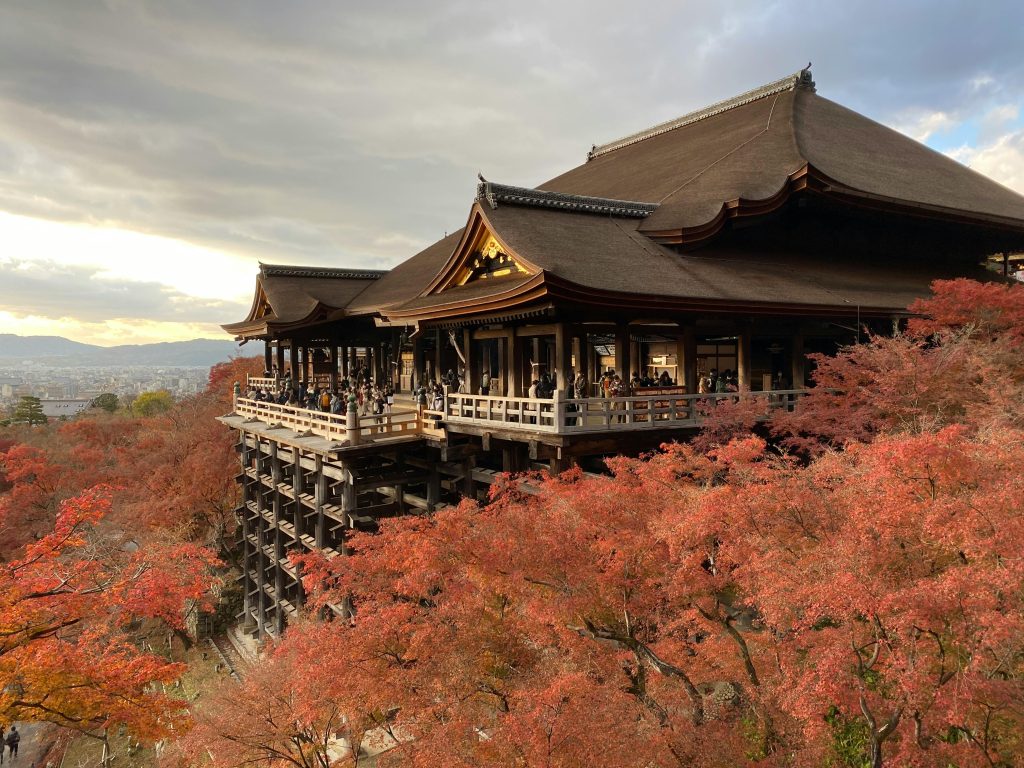
The temple’s architecture is mind-blowing: it hangs off a cliff using nothing but wooden joints—no nails! Be sure to walk through the pitch-black Tainai Meguri beneath the main hall, Zuigu-do Hall. Tainai Meguri translates to “journey to the womb” in Japanese and symbolizes returning to the womb and emerging reborn – quite the impressive way to start the morning. This is a separate 100 yen ticket.
Finally, stop by the Otowa waterfall at the bottom of the terrace after you walk down a flight of stairs. The pure water here is divided into three streams, and it may be drunk through long metal ladle sterilized by UV light. My advice would be to drink from all three streams: one is said to bring academic success, the second longevity, and the third success in love.
9:00 AM – Nanzen-ji By now, the crowds at Kiyomizu are starting to get thick, so head to Nanzen-ji. It’s easiest to take a taxi here or you can attempt the 45-minute walk between temples. You can also take two different buses to get here. This sprawling Zen temple complex feels more like a small town. The surprise star here? A massive brick aqueduct that looks like it was teleported from ancient Rome. Climb up to the Sanmon Gate and get another incredible view of Kyoto. And don’t skip the garden at Nanzen-in sub-temple. This area is particularly beautiful in autumn, so if you can visit during that time, do it! Nanzen-ji has also become the setting for a lots of Japanese movies and TV dramas. Entrance is free.
10:30 AM – Eikandō While we’ve got you over in this area, you may as well walk five minutes north to Eikandō, a major Buddhist temple with a famous statue of Buddha with his head turned to one side rather than facing forward. According to legend, a head monk was performing a ritual for the statue when the Buddha statue turned to face him and spoke to him. The temple used to be a villa that belonged to a nobleman who gave it a Buddhist priest as a gift in 853. Eikandō is especially mesmerizing during the autumn. The covered wooden walkways wind through the hills like a meditation in architecture.
Break for Lunch and then head to the Philosopher’s Path
Eikandō is located right at the bottom of the Philosopher’s Path, also known as Tetusgaku no Michi. This 2-km path stretches along the Lake Biwa Canal lined with cherry blossoms in the spring and stunning autumn leaves in the fall. The Philosopher’s Path is named after a Kyoto University professor, Nishida Kitaro, who used to go for meditative walks. Before lunch, head to Okonomiyaki Zen for a delicious Japanese-style pancake, Asano Cafe & Lunch for omurice (Japanese omelet + rice) or curry, or Hinode Udon to try some delicious udon. All of these lunch spots are right next to each other and can be found with a quick Google Maps search.
Once you’ve finished your traditional Japanese lunch, head over to the Philosopher’s Path and take the long stroll north along the canal. There are some adorable cafés along this route, such as And Bull Coffee, Kuroganeya, and Pomme, where you can take your time, and enjoy a matcha latte or Japanese sweet.
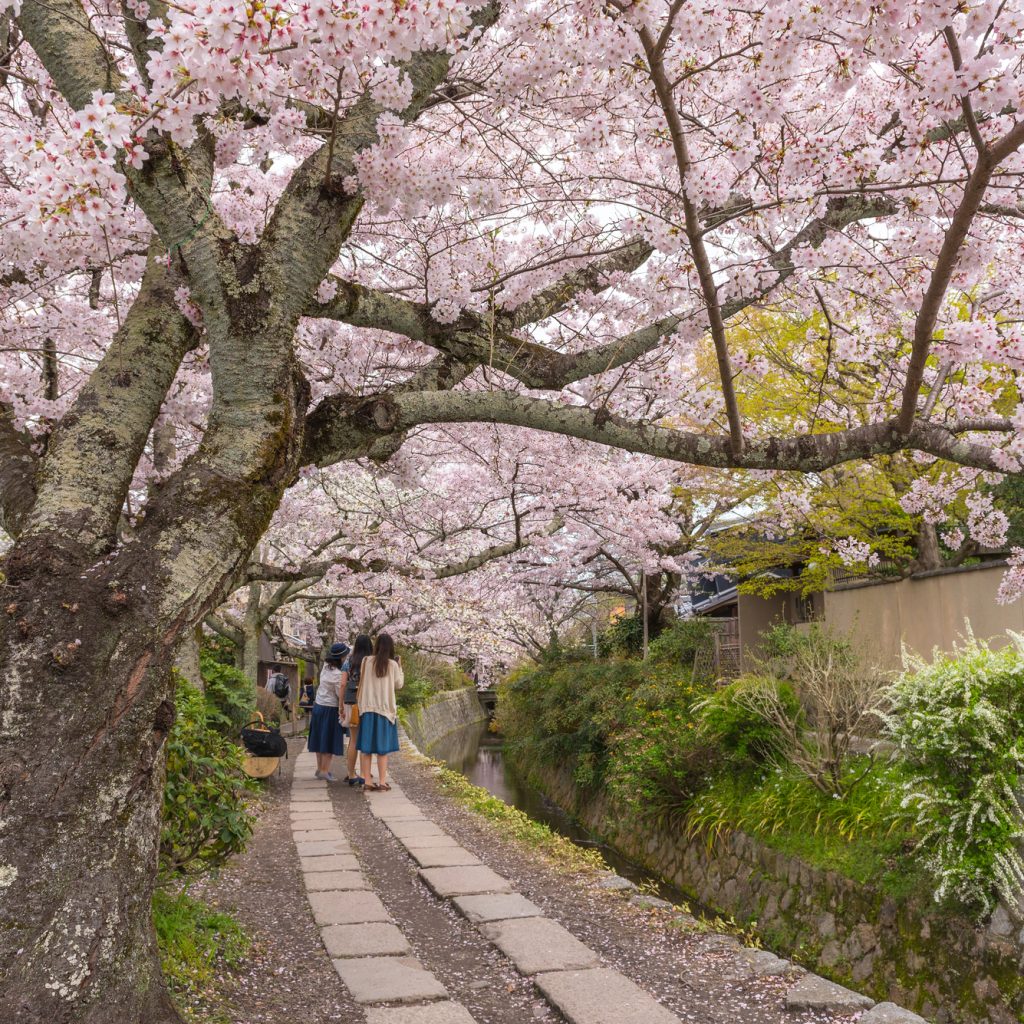
2:00 PM – Ginkaku-ji (Silver Pavilion) (Higashiyama Jisho-ji in Google Maps) After your coffee break, you will be well positioned to head over to Ginkaku-ji (not to be confused with its more famous brother Kinkaku-ji, the Golden Pavilion, which we will see tomorrow. Despite its name, there’s not a speck of silver on this temple—but that’s part of its charm. The minimalist aesthetic here is pure Zen poetry. The sand garden next to the temple features this massive sculpted sand cone that’s supposed to reflect moonlight into the garden. Whether it works or not, it’s incredibly impressive. Keep in mind that this temple closes at 5:00 pm, so it’s best to arrive no later than 4:00 pm.

4:00 PM – Head back home for a break – We know, we know. It seems like we’re stopping you quite early for the day when it comes to temples, but do you remember how early you woke up? Make sure way back towards your accommodation near Kyoto Station and take an hour to relax and change clothes if you need to because you’re going out around 5:00 pm to the Geisha and Maiko (apprentice geisha) district for a change of pace this evening.
5:00 PM – Now, it’s time to explore Pontocho, a historic district in Kyoto known for its narrow alleyways lined with traditional wooden buildings, teahouses, and restaurants. Situated along the Kamogawa River, this area gives us a glimpse into a different side of Kyoto culture. It’s one of the best places to spot Geisha and Maiko, especially in the evenings when they walk between appointments. The district of Gion is a short 10-minute walk away.
The most famous alley, Pontocho-dori, is a hotspot for these traditional performers. Pontocho has been a hub of entertainment since the Edo period. While you’re in the area, you should also explore nearby Hanami-koji, another famous street where Maiko and Geisha are often seen. When it comes to taking pictures of the geisha or maiko, please do it very discreetly. When I took photos, I only did it from afar, as it is considered very rude to ask the maiko or geisha for photos. You should never take a photo of a geiko or maiko with their leg exposed under their kimono or when they are with a client. These are big taboos in Japanese culture. Note: it might be more fun for you to dress up in a kimono yourself and take photos.

While in Pontocho, find a nice place for dinner and try a different type of Japanese food than you had for lunch. One option could be Pontocho Yakiniku Yamakawa, which serves wagyu and Kobe beef that you order from a screen and cook yourself on a small grill at your table. Would you like to try boiled dumplings from a family recipe? Then, head to Shantan right next door to Pontocho Yakiniku. Alternatively, you can book a night foodie tour or a walk through the geisha district in the area and be guided to local bars and restaurants.
After enjoying a nice Japanese Asahi or Sapporo beer to end the evening, stop by another convenience store to load up on breakfast and sports drinks/bottled water for tomorrow because – you guessed it – it’s going to be another early morning!
Pro Tips for Day 1:
- Pack a small towel and a bottle of water in your day bag. You will be walking up and down a lot of stairs throughout the day. Wear comfortable shoes.
- The Philosopher’s Path is gorgeous in any season, but it’s absolute peak Japan during cherry blossom season. If you’re here in early April, you might want to do this walk closer to sunset when the evening light hits the blossoms. The same can be said about the autumn leaves.
DAY 2: Southern and Western Kyoto
5:00 AM – Fushimi Inari Shrine I know, I know—another crack-of-dawn start. But trust me: this is the only way to experience the magical tunnel of thousands of vermillion torii gates without feeling like you’re in a crowded subway car. After eating your convenience store breakfast, get on the Nara Subway Line from Kyoto Station and take the quick 7-minute ride over to Inari Station. Bring a flashlight and watch the sunrise transform the gates from mysterious shadows to brilliant orange as you through the tunnel of gates up Mount Inari. By 7:00 am, you’ll be heading down while the crowds are heading up. It usually takes around 1 hour to 90 minutes to get to the top and 30-45 minutes to get down depending on your fitness level.
Fushimi Inari dates back to 711 AD. It is dedicated to Inari, the Shinto god of rice. You will see many fox statues throughout the shrine’s grounds because foxes are said to be the messengers of Inari.
If you would prefer to start early with a guide, you can check out this tour of Fushimi Inari.



8:00 AM – Heian Jingu After your early morning torii gate adventure, head to Heian Jingu, about 30 minutes from Fushimi Inari. Take the Keihan Main Metro Line to Sanjo Station and walk about 15 minutes to the shrine, which is open from 6:00 am every day. By the time you arrive, there may already be a few tour buses, but hopefully you will have most of Heian Jingu and the four distinctive parts of its gardens to yourself.
If Heian Jingu looks familiar when you first arrive, it’s because this is the only shrine that Scarlett Johansson’s character, Charlotte, visits during her trip to Kyoto in the film Lost in Translation. This shrine is a relative newcomer to Kyoto (built in 1895), but what it lacks in age, it makes up for in pure drama. The massive vermillion torii gate marking the entrance makes you feel like you’re walking into an emperor’s domain—which, actually, you kind of are, since this shrine was built to honor Kyoto’s original imperial legacy.
But here’s the real secret: It’s the gardens that are the real attraction here! Ogawa Jihei VII, part of the famous lineage of Kyoto garden designers, spent 20 years creating them and they are pure magic in the spring and fall. My favorite is the South Garden, the last one you will enter, with its huge pond and covered walkway over the water.


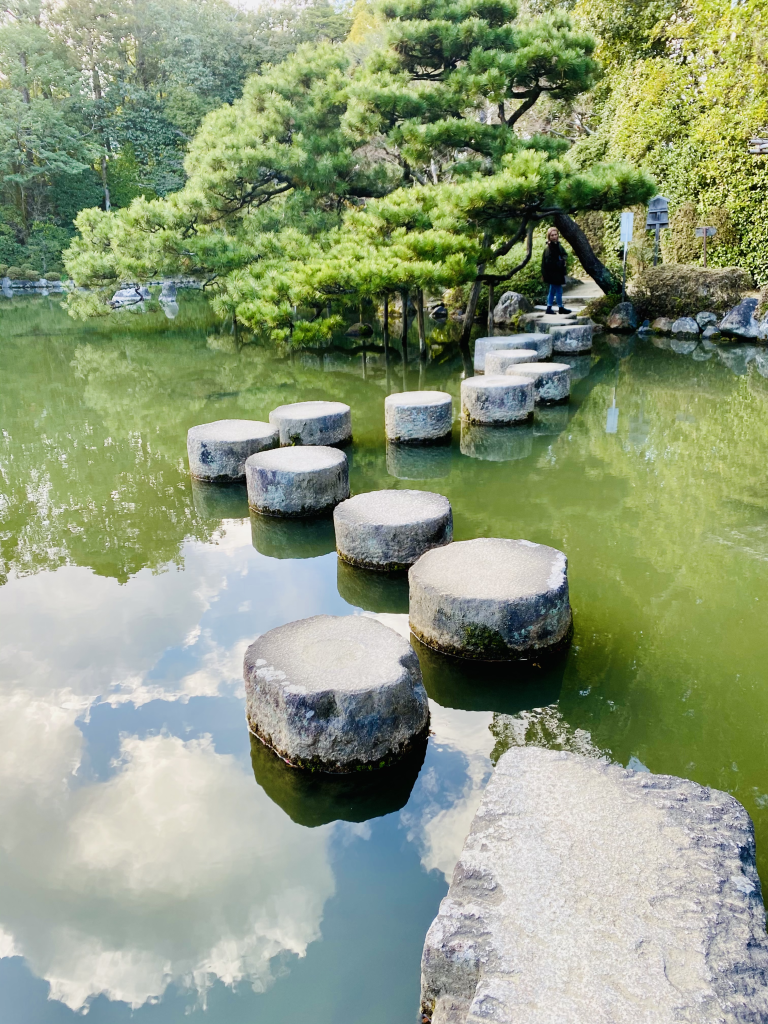
10:30 AM – Sanjūsangendo Temple If you ask me what my favorite temple is (gardens not included), Sanjūsangendo is the one! I always feel like I’m missing something when I can’t visit the 1,001 life-sized golden statues of the Buddhist deity Kannon, standing in perfect rows in Japan’s longest wooden building. The morning light through the ancient windows creates this ethereal glow that makes all those golden statues seem alive. Fun fact: the temple got its name because the building has 33 spaces between its support columns (sanjūsan = 33). Of all the temples in Kyoto, this one really makes me feel like I’ve stepped back in time. It also never seems as crowded as some of the others. My mind is blown each time I return.
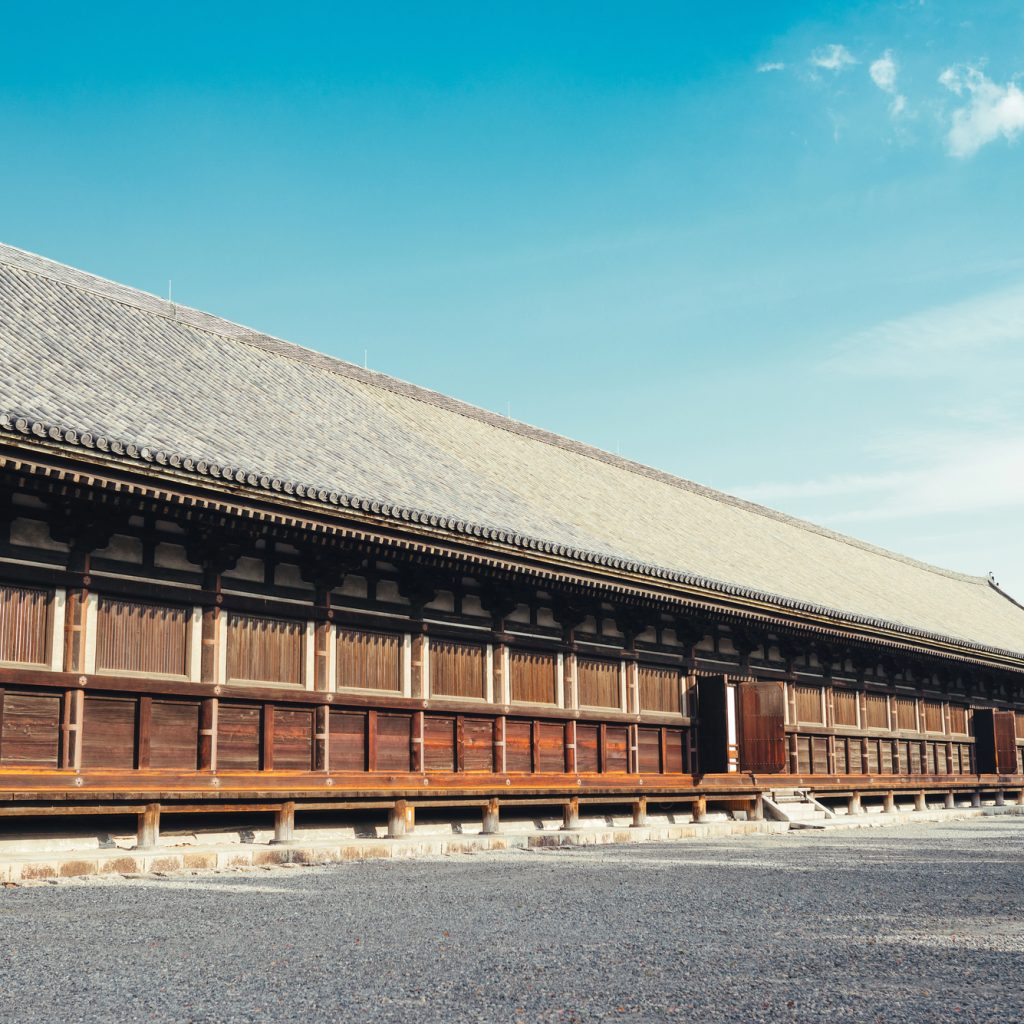
Break for Early Lunch on the Kamo River
For lunch, I only have one recommendation, which is a short 8-minute walk from Sanjūsangendo Temple. Veg Out is an organic vegan café run by a yoga studio. Trust me, even if you’re not a vegan or vegetarian, you will find something to love here. Dishes also include dishes made from Kyoto heirloom vegetables known as “Kyo-yasai.” What keeps bringing me back is the calm vibe and beautiful window onto the Kamo River, where you can watch people cycle and stroll along and imagine others who have done the same over the centuries. Kyoto can seem so crowded at times, but this is a moment of peace.
If you arrive around 11:30 am, you should be able to get a seat fairly quickly.


1:30 PM/2:00 PM – Kinkaku-ji (The Golden Pavilion) Prepare for our mid-day transit to the Eastern Side of the City. It should take about 45 minutes total to reach the first of our final two temples of the day. There’s no quiet time at Kinkaku-ji—it’s always packed. However, if we arrive while people are still at lunch, we may have a chance to enjoy Kinkaku-ji when it’s not a crazy-level of crowded.
This is one of the top two most famous temples in Kyoto (Fushimi Inari being the most popular). Yes, it’s touristy. Yes, it’s worth it, but feasting your eyes upon the Golden Pavilion, whose top two floors are covered in gold leaf, and seeing the golden reflection on the mirror pond will make you forget about every annoyance. Just don’t expect to explore inside—as you’re not allowed to go into the Golden Pavilion. This temple also doesn’t take too long to visit.

3:30 PM – Ryoan-ji End your temple marathon on Day 2 with Japan’s most famous Zen rock garden. This is only a short 20-minute walk from Kinkaku-ji. By the afternoon, most tourists have temple fatigue, which will give you the chance to contemplate those 15 mysterious rocks in relative peace. Fun fact: you can never see all 15 rocks at once from any angle. It’s like a 500-year-old optical illusion that still messes with your mind. There is always one missing. Ryoan-ji closes at 5:00pm, so make sure you enter no later than 4:00 pm.
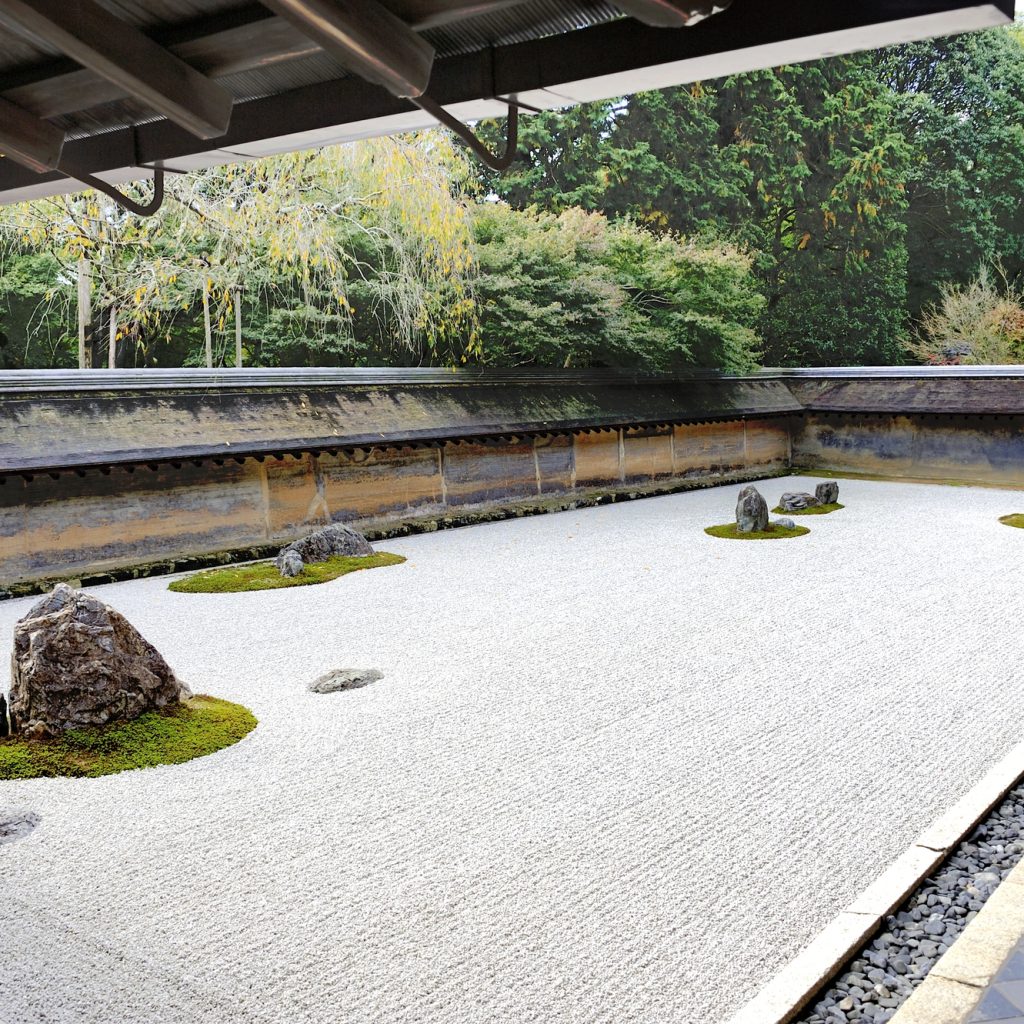
5:30 PM/6:00 PM Menbaka Fire Ramen Celebrate a successful second day in Kyoto with dinner and a show at Menbaka Fire Ramen. And when I say “fire,” I mean it literally—they set your ramen on FIRE right in front of you with a fireball that almost goes to the ceiling. Don’t worry about your eyebrows though; they’ve got this down to a science. They will even take your phone and expertly record the entire experience for you from one of several selfie sticks they have propped up behind the counter.
The theatrical flame-up is cool, but the ramen itself is seriously good too. Three things you should know though:
1) Menbaka Fire Ramen doesn’t take reservations so you will have to wait in line. The wait may take as long as two hours since they only seat about ten people at a time, do the whole fire show, and then let more people in.
2) Most people who come to Menbaka are tourists, probably in part because of the high price of the ramen.
3) The owner, a very engaging guy, has his own little pamphlet with his favorite off-the-beaten-path temples in Kyoto – ask for a free copy.
Menbaka Fire Ramen closes at 9 pm, which leaves us plenty of time to get to bed early, as we always do in Kyoto. One more day to go!

Pro Tips for Day 2:
- At Fushimi Inari, the further up you climb, the fewer people you’ll see. Most tourists only go to the first viewing point. Push just 10 minutes beyond that and you’ll have those orange gates almost to yourself.
- At Heian Jingu, the east garden is particularly spectacular during iris season in late spring. If you’re lucky enough to be there in June, you’ll see thousands of purple irises in bloom.
- There’s a little-known second-floor cafe in the Heian Jingu museum building with huge windows overlooking the shrine grounds. Perfect spot for a mid-morning coffee break.
- Consider buying a combination ticket for Heian Jingu that includes both the shrine and garden access—it’s cheaper than paying separately, and you definitely want to see those gardens.
- Bring a sketchbook to Ryoan-ji. Even if you’re not an artist, sitting there and trying to draw the rock garden is a meditative experience in itself.
- If you’re visiting in summer, all these temples will be HOT. Plan to buy a paper fan from one of the souvenir shops—they’re cheap and surprisingly effective.
DAY 3: Western Kyoto & Central Kyoto
7:00 AM – Arashiyama Bamboo Grove Are you excited for your last early start in Kyoto? This time, let’s leave at a kinder 7:00 am and take a 30-minute ride on the San-In Metro Line to Saga-Arashiyama Station. A fifteen-minute walk from the station will bring you to the world famous Bamboo Forest, which is otherworldly in the early morning light before the Instagrammers descend. The morning light filtering through those massive stalks creates shadows that’ll make you feel like you’re walking through a living Japanese ink painting.
If you’d like to be guided through Arashiyama instead, you can book this tour that will go deeper into the history and culture of Arashiyama.


9:00 AM – Okochi Sanso Garden After getting all the perfect shots of the bamboo, you’ll be in the perfect position to be one of the first to enter the gates of the Okochi Sanso Garden. Although it’s right next to the bamboo path, it’s usually overlooked by the Instagrammers unaware that they’re walking right past this hidden gem. This was the private villa of a famous Japanese actor, and honestly? It might be the most perfectly designed garden in Kyoto. Your entrance fee includes traditional green tea and a sweet in a tea house overlooking the city. Slowly climb the hills, wander around the grounds, and enjoy the view over the valley. I recommend having your tea after you’ve explored the surroundings. Sip slowly—this view of Kyoto is worth savoring and at this hour, you will feel like the only one in town. Note: this garden does have one of the most expensive entrance fees in Kyoto at ¥1,000.


10:30 AM/11:00 AM – Otagi Nenbutsji Temple Ready to get way off the beaten path and be captivated by the magic of Kyoto? Once you exit Okochi Sanso, get ready for an absolutely lovely 30-minute walk through the northwestern edge of Kyoto to the rarely visited Otagi Nenbutsuji Temple. I visited this temple during my first visit to Kyoto in 2005 and fell in love with its peaceful beauty.
Otagi Nenbutsuji Temple is located in the forest surrounded by greenery and the smell of moss and ferns. Once you arrive, you realize that you’re not alone. In fact, you are surrounded by hundreds of rakan, unique carved statues that are Buddha’s disciples. Each of these statues has their own personality with different hand positions and expressions. In fact, they say that you are supposed to find yourself – as in your statue – among the hundreds around you. Can you find yourself? Go on and try!
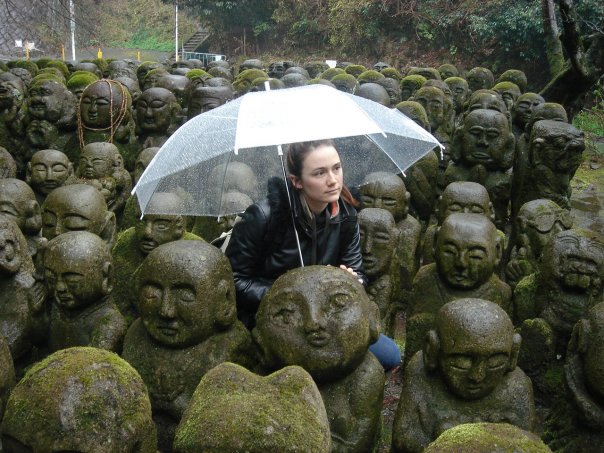
Lunch in the Forest
There are a number of enchanting lunch spots along the walk back from Otagi Nenbutsuji Temple to Saga-Arashiyama Station. Try delicious sweet and spicy beef udon with yuzu at Café Gabu or try Japanese kaiseki at Toriimoto Yusan. Grab a coffee or a hot wine at Atago Base or make your own match drink at Saga Toriimoto Tea and Coffee Hijiri (嵯峨鳥居本 お茶と珈琲 聖) just a few shops down from Adashino Iwai. This is a great place to do some souvenir shopping at Adashino Mayumura before we head back into the central part of town.
2:30 PM – Shōseien – Let’s get back into the central part of Kyoto to finish our amazing three days in Kyoto. Shōseien is a historic strolling garden associated with Higashi Hongan-ji Temple. Originally built in the 17th century as a detached residence for the temple’s head priests, the garden was designed in the classical Japanese style. It features a large central pond and delightful bridges. Despite suffering damage from fires over the centuries, Shōseien has been carefully restored. There shouldn’t be too many people here in the afternoon and visiting this area brings us right back to the center of the action for dinner.

After you say goodbye to your final Japanese garden in Kyoto, you now have time to do some shopping along Shijo and Kawaramachi Streets. My favorite is nama yatsuhashi. These are delicious triangular sweets made from soft mochi wrapped around red bean paste. You can get a variety of flavors including strawberry, cinnamon, or my favorite matcha green tea. You can also buy nama yatsuhashi at the train station and enjoy them on the shinkansen.
7:00 PM – For your final dining experience in Kyoto, I recommend one of two things: either book a food tour to get a wide range of experiences or plan in advance to have a meal you will never forget at a place like Sui Fine Dining (reservations required by calling +81-75-754-8235 or emailing gion.sui@gmail.com). Kyoto clearly has 5-star quality food that frequently makes the best in the world lists. Do you research and be prepared for a meal like no other.
Pro Tips for Day 3:
- Bring your camera to the bamboo grove, but also take a moment to just stand there and listen. The sound of bamboo swaying and knocking together is pure magic.
- Getting thirsty? There is never a vending machine far away in Japan, and they serve both hot and cold drinks depending on the season – to keep you hydrated on the long walk.
- If you want to skip the 30-minute walk from Okochi Sanso to Otagi Nenbutsiji, you can take Bus #62 from Nonomiya (check Google Maps for this). Be sure to have some coins on you for this just in case.
There you have it—three perfect days in Kyoto that ensures that you will avoid the majority of the crowds while seeing the best that Japan’s ancient capital has to offer. Just remember: early mornings are your best friend, comfortable shoes are your second-best friend, and a sense of wonder is absolutely required. Now go forth and explore!
The best moments happen when you get a little lost between temples. Oh, and always, always carry a water bottle and an umbrella if there is rain in the forecast.
Follow this itinerary, and I promise you’ll see the Kyoto that made me fall in love with this city twenty years ago.
Fun Tours to Book in Kyoto
While you’re enjoying your three days in Kyoto, you can also check out these cultural tours that will add even more magic to your days.
Try your hand at being a samurai
Take part in a Japanese tea ceremony dressed in a kimono
Sip on sake at a 3-hour sake tasting experience
Find out what’s it’s like to be a ninja
Explore Kyoto – Private Tour with local English-speaking driver (guide option)
Let me know what Kyoto temple or shrine is your favorite in the comments!
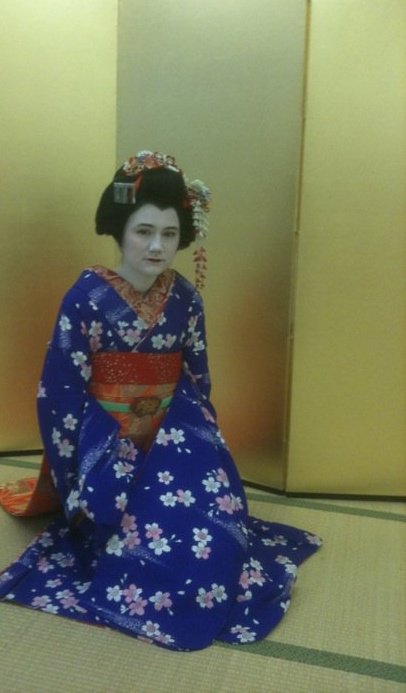


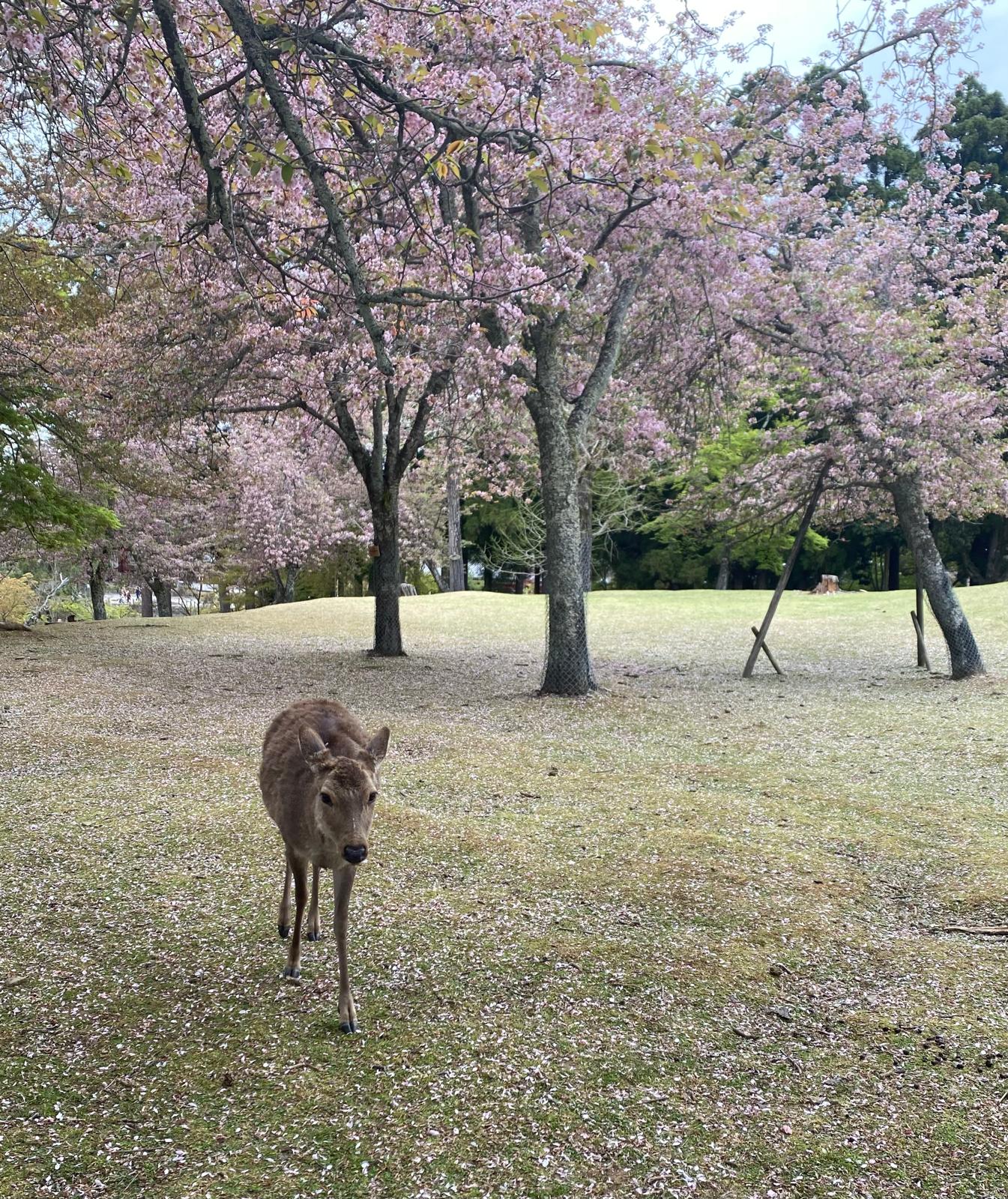
Thank you Tokyo Becky,
Many thanks for this blog, we have followed 2 days of your itinerary in Kyoto + 1 day in Nara.
Really enjoyed it and appreciated your recommendations – keep up the good work.
Dear Mary,
Thank you so much for your email. I am so glad that you enjoyed the itinerary in Kyoto, and I hope it inspires you to come back.
All the best,
Tokyo Becky